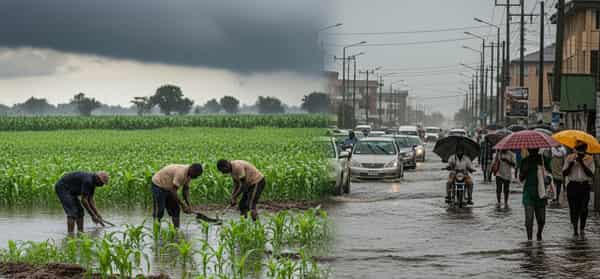An early morning downpour on Thursday disrupted movement in several parts of the Federal Capital Territory (FCT), leaving residents stranded and heightening safety concerns.
Worst-hit areas included Guzape and Asokoro, where shops and vehicles were submerged as floodwaters rose above knee level. Motorists were forced to abandon their cars, and many commuters waded through the water to reach safety.
Viral videos and eyewitness accounts showed cars nearly submerged as flash floods swept through the districts, once again raising concerns about Abuja’s drainage infrastructure. Traffic gridlock kept many stranded for about two hours.
The flooding occurred just days after the Federal Capital Territory Emergency Management Department (FEMD) issued a public advisory warning of likely heavy rainfall across Abuja and neighbouring states.
Acting Director-General of FEMD, Mr. Abdulrahman Mohammed, had cautioned residents against driving into flooded areas and urged them to wait until floodwaters receded before attempting to cross.
He also advised households to switch off electrical appliances during storms and report emergencies using the 112 toll-free line.
The warning echoed the Nigerian Meteorological Agency’s (NiMet) forecast of thunderstorms and heavy rains across Abuja, Niger, Nasarawa, Kwara, Kogi, Benue, and Plateau States earlier in the week.
NiMet also projected similar weather conditions in parts of Taraba, Adamawa, Kano, Kaduna, Katsina, Zamfara, Jigawa, Borno, Gombe, and Bauchi States.
Officials have renewed calls for vigilance, stressing the need for residents to take weather alerts seriously to prevent avoidable loss of lives and property.
Flooding has long plagued Abuja, particularly in districts such as Gwagwalada, Kado, Karu, Kubwa, and Lokogoma, where rapid urbanisation and blocked drainage channels worsen the problem.
Notable incidents include the 2011 flood that displaced over 1,000 residents in Gwagwalada, the 2017 flash floods that killed several people in Lokogoma and Galadimawa, and the 2021 Lugbe and Trademore Estate flood that claimed lives and destroyed property worth millions.
Urban planners and residents alike have repeatedly called for urgent upgrades to the city’s drainage infrastructure, stricter regulation of building developments on floodplains, and improved waste management to mitigate the perennial risk.






